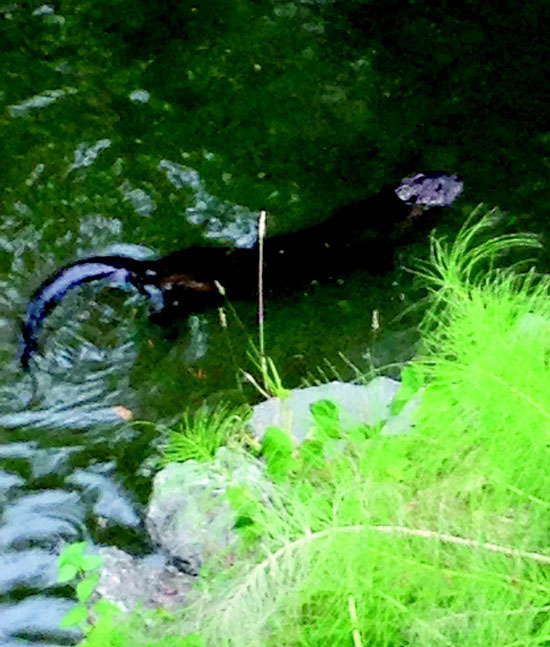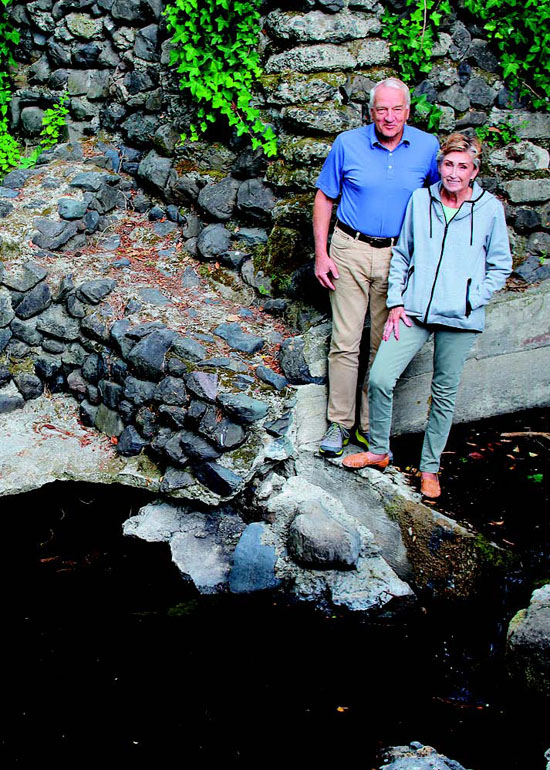|
|
Published July 15th, 2015
|
Otters Starting a Return to Lamorinda Creeks?
|
| First otter in an Orinda creek spotted |
| By Chris Lavin |
 |
| Otter spotted in San Pablo Creek near the Sturgeses' Orinda home Photo Karen Sturges |
A recent chain of events set the Orinda creeks and environmental movement atwitter this month when a couple who has lived on Moraga Way for more than 20 years spotted an otter in San Pablo Creek, right behind their house.
 Thomas Sturges was in his workshop, doing his usual gardening and workshop-like tasks, sharpening stuff and putting things away, when he saw a large wake in the creek behind the building.
Thomas Sturges was in his workshop, doing his usual gardening and workshop-like tasks, sharpening stuff and putting things away, when he saw a large wake in the creek behind the building.
 "I saw a big ripple, and thought, 'That's quite a fish!' So I stepped out to look, and saw it was an otter," Sturges said. There it was, swimming through the creek, probably looking for crayfish, near a culvert on San Pablo Creek that runs right behind their house by McDonnell Nursery. He told his wife, Karen, about it.
"I saw a big ripple, and thought, 'That's quite a fish!' So I stepped out to look, and saw it was an otter," Sturges said. There it was, swimming through the creek, probably looking for crayfish, near a culvert on San Pablo Creek that runs right behind their house by McDonnell Nursery. He told his wife, Karen, about it.
 "We see him, or her, about once a week now," said Karen Sturges. She got her phone ready and started snapping pictures when he (or she) was around. "The otter doesn't stand still," she said with frustration, a problem for photographic purposes. When asked to provide some more high-quality photos of the otter, she did. Her son Derek calls her the techie in the house.
"We see him, or her, about once a week now," said Karen Sturges. She got her phone ready and started snapping pictures when he (or she) was around. "The otter doesn't stand still," she said with frustration, a problem for photographic purposes. When asked to provide some more high-quality photos of the otter, she did. Her son Derek calls her the techie in the house.
 The Sturgeses visited the Friends of Orinda Creeks' booth during Orinda's Fourth of July celebration, and told volunteers there about their find. The otter was about the size of a big house cat, they said, and Karen Sturges had pictures on her phone to prove it. Word quickly spread.
The Sturgeses visited the Friends of Orinda Creeks' booth during Orinda's Fourth of July celebration, and told volunteers there about their find. The otter was about the size of a big house cat, they said, and Karen Sturges had pictures on her phone to prove it. Word quickly spread.
 "I am highly excited by the otter," said Michael McGowan of Friends of Orinda Creeks, adding that he thinks it brings good news about the improving health of local creeks.
"I am highly excited by the otter," said Michael McGowan of Friends of Orinda Creeks, adding that he thinks it brings good news about the improving health of local creeks.
 Megan Isadore, the executive director of the River Otter Ecology Project, which collects information about river otters in Central California, thinks McGowan is right.
Megan Isadore, the executive director of the River Otter Ecology Project, which collects information about river otters in Central California, thinks McGowan is right.
 "Otters are clearly repopulating in the Bay Area, but they are mostly going south," Isadore said, into the environs of the South Bay. Yet the appearance of an otter on San Pablo Creek is indicative of a bigger issue: the return of more normal health to the Lamorinda watershed after decades of abuse. Otters used to be all over the area, but they were extirpated almost completely by the middle of the 1900s, Isadore said. Part of that was water quality; part of it was a large use of pesticides.
"Otters are clearly repopulating in the Bay Area, but they are mostly going south," Isadore said, into the environs of the South Bay. Yet the appearance of an otter on San Pablo Creek is indicative of a bigger issue: the return of more normal health to the Lamorinda watershed after decades of abuse. Otters used to be all over the area, but they were extirpated almost completely by the middle of the 1900s, Isadore said. Part of that was water quality; part of it was a large use of pesticides.
 River otters have long been spotted in the San Pablo and Lafayette reservoirs, even Briones, while none in Upper San Leandro Reservoir. One was spotted in 2013 in Las Trampas Creek in Lafayette. But the sighting on San Pablo Creek is a first - and a mystery. Isadore said it probably came from one of the reservoirs, but those are miles away.
River otters have long been spotted in the San Pablo and Lafayette reservoirs, even Briones, while none in Upper San Leandro Reservoir. One was spotted in 2013 in Las Trampas Creek in Lafayette. But the sighting on San Pablo Creek is a first - and a mystery. Isadore said it probably came from one of the reservoirs, but those are miles away.
 "Otters can travel a long way over land," she said. If it came from San Pablo Reservoir, it would have had to negotiate miles of culverts and pipes unless it decided to negotiate traffic on Highway 24. And Lafayette Reservoir is a bit closer, but that journey would have required even more overland trekking.
"Otters can travel a long way over land," she said. If it came from San Pablo Reservoir, it would have had to negotiate miles of culverts and pipes unless it decided to negotiate traffic on Highway 24. And Lafayette Reservoir is a bit closer, but that journey would have required even more overland trekking.
 Isadore's project has initiated an investigative experiment partly to answer precisely this question: If she can find enough scat, test results will help develop a DNA pattern for families and populations in the Bay Area that can lead to individuals such as the Orinda creek otter.
Isadore's project has initiated an investigative experiment partly to answer precisely this question: If she can find enough scat, test results will help develop a DNA pattern for families and populations in the Bay Area that can lead to individuals such as the Orinda creek otter.
 "It's expensive, and it takes time," said Isadore, who is concentrating now on the Marin County river otter populations.
"It's expensive, and it takes time," said Isadore, who is concentrating now on the Marin County river otter populations.
 River otters are smaller in size than sea otters, they have more pups, they are larger by body size and they eat differently. River otters will take a crayfish or fish or frog out of the water and have a picnic on the shore; sea otters just turn over and eat off their bellies. (Think of who you would rather have over for supper.) River otters are more agile on land.
River otters are smaller in size than sea otters, they have more pups, they are larger by body size and they eat differently. River otters will take a crayfish or fish or frog out of the water and have a picnic on the shore; sea otters just turn over and eat off their bellies. (Think of who you would rather have over for supper.) River otters are more agile on land.
 But this reporter had a nagging worry: Won't the Orinda creek otter get lonely?
But this reporter had a nagging worry: Won't the Orinda creek otter get lonely?
 "Otters have a very fluid social life," Isadore said with a laugh. "They are extremely adaptable. They can be social. Females and males will usually stay apart. But this is most likely a male dispersing from his family group."
"Otters have a very fluid social life," Isadore said with a laugh. "They are extremely adaptable. They can be social. Females and males will usually stay apart. But this is most likely a male dispersing from his family group."
 In case he (or she) finds a partner, Karen Sturges will be standing by, iPhone in hand.
In case he (or she) finds a partner, Karen Sturges will be standing by, iPhone in hand.
 For more information about Bay Area otters, or to report a sighting or scat, visit www.riverotterecology.org. For information about Orinda creeks, visit www.orindacreeks.org.
For more information about Bay Area otters, or to report a sighting or scat, visit www.riverotterecology.org. For information about Orinda creeks, visit www.orindacreeks.org.

|
 |
| Thomas and Karen Sturges stand at the spot in their back yard in Orinda where they started spotting an otter on San Pablo Creek this month. It's the first known return of an otter to an Orinda creek since they were wiped out in the last century. Photo Chris Lavin |
|
|
|
|
|
|
| |
|
|
|
|





